Human Resource Management References
VerifiedAdded on 2020/10/05
|14
|4473
|451
AI Summary
This assignment involves analyzing and summarizing references related to human resource management. The provided sources include articles and books on various HRM functions, such as strategic human resources management, performance management, employee engagement, presenteeism in the workplace, sustainability in the hospitality industry, age discrimination laws, and international human resource management. The references are from reputable journals like the Journal of Organizational Change Management, Public Personnel Management, Human Resource Management Review, and International Journal of Contemporary Hospitality Management.
Contribute Materials
Your contribution can guide someone’s learning journey. Share your
documents today.
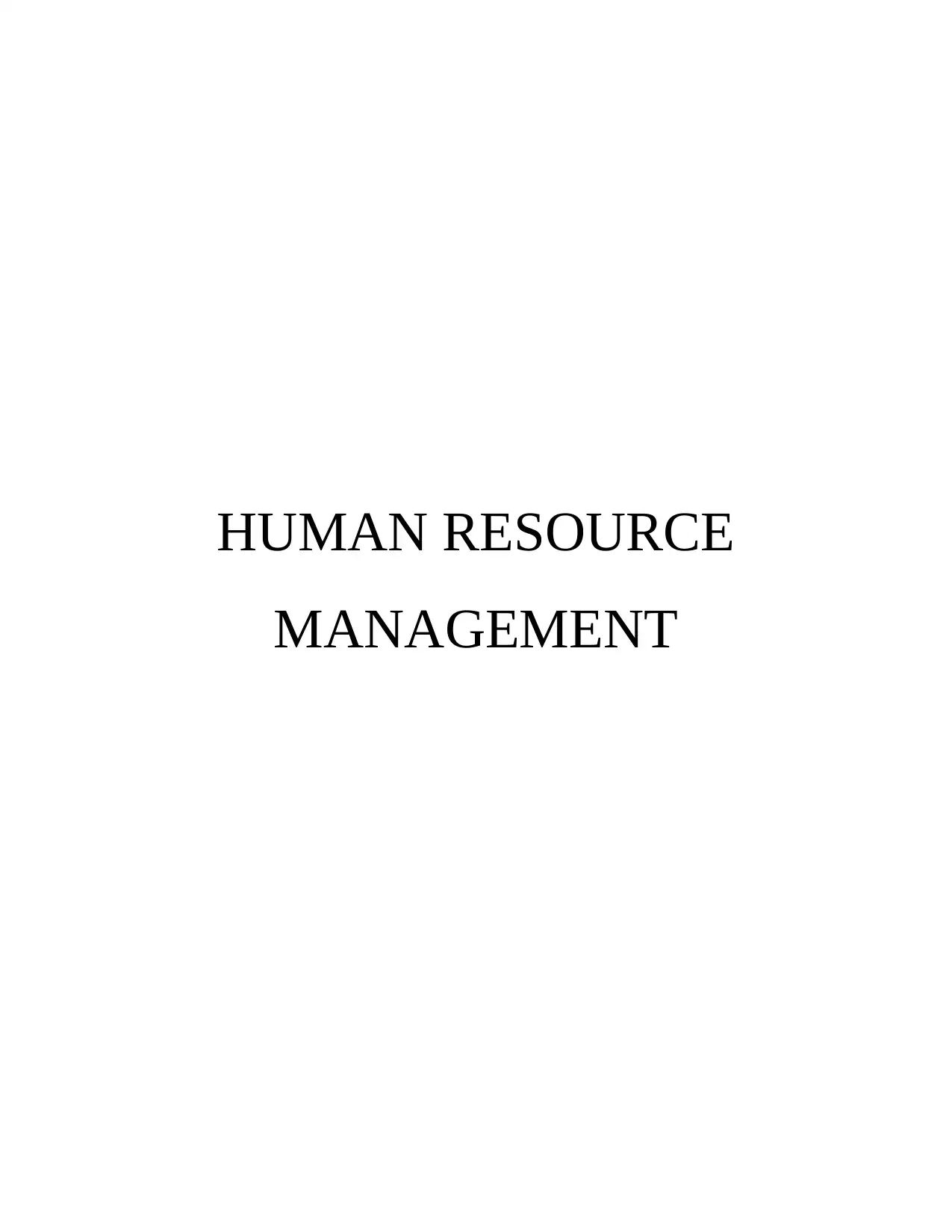
HUMAN RESOURCE
MANAGEMENT
MANAGEMENT
Secure Best Marks with AI Grader
Need help grading? Try our AI Grader for instant feedback on your assignments.

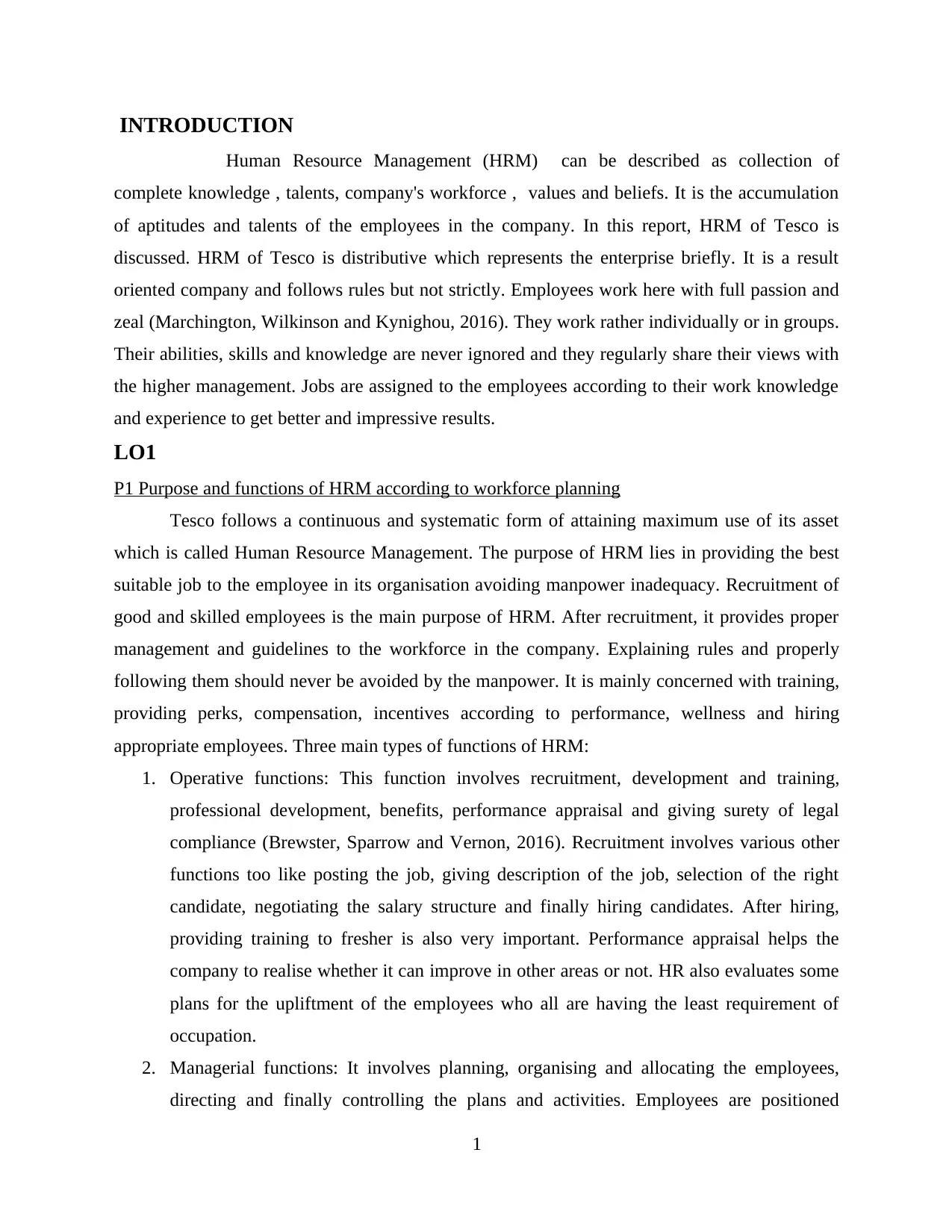
INTRODUCTION
Human Resource Management (HRM) can be described as collection of
complete knowledge , talents, company's workforce , values and beliefs. It is the accumulation
of aptitudes and talents of the employees in the company. In this report, HRM of Tesco is
discussed. HRM of Tesco is distributive which represents the enterprise briefly. It is a result
oriented company and follows rules but not strictly. Employees work here with full passion and
zeal (Marchington, Wilkinson and Kynighou, 2016). They work rather individually or in groups.
Their abilities, skills and knowledge are never ignored and they regularly share their views with
the higher management. Jobs are assigned to the employees according to their work knowledge
and experience to get better and impressive results.
LO1
P1 Purpose and functions of HRM according to workforce planning
Tesco follows a continuous and systematic form of attaining maximum use of its asset
which is called Human Resource Management. The purpose of HRM lies in providing the best
suitable job to the employee in its organisation avoiding manpower inadequacy. Recruitment of
good and skilled employees is the main purpose of HRM. After recruitment, it provides proper
management and guidelines to the workforce in the company. Explaining rules and properly
following them should never be avoided by the manpower. It is mainly concerned with training,
providing perks, compensation, incentives according to performance, wellness and hiring
appropriate employees. Three main types of functions of HRM:
1. Operative functions: This function involves recruitment, development and training,
professional development, benefits, performance appraisal and giving surety of legal
compliance (Brewster, Sparrow and Vernon, 2016). Recruitment involves various other
functions too like posting the job, giving description of the job, selection of the right
candidate, negotiating the salary structure and finally hiring candidates. After hiring,
providing training to fresher is also very important. Performance appraisal helps the
company to realise whether it can improve in other areas or not. HR also evaluates some
plans for the upliftment of the employees who all are having the least requirement of
occupation.
2. Managerial functions: It involves planning, organising and allocating the employees,
directing and finally controlling the plans and activities. Employees are positioned
1
Human Resource Management (HRM) can be described as collection of
complete knowledge , talents, company's workforce , values and beliefs. It is the accumulation
of aptitudes and talents of the employees in the company. In this report, HRM of Tesco is
discussed. HRM of Tesco is distributive which represents the enterprise briefly. It is a result
oriented company and follows rules but not strictly. Employees work here with full passion and
zeal (Marchington, Wilkinson and Kynighou, 2016). They work rather individually or in groups.
Their abilities, skills and knowledge are never ignored and they regularly share their views with
the higher management. Jobs are assigned to the employees according to their work knowledge
and experience to get better and impressive results.
LO1
P1 Purpose and functions of HRM according to workforce planning
Tesco follows a continuous and systematic form of attaining maximum use of its asset
which is called Human Resource Management. The purpose of HRM lies in providing the best
suitable job to the employee in its organisation avoiding manpower inadequacy. Recruitment of
good and skilled employees is the main purpose of HRM. After recruitment, it provides proper
management and guidelines to the workforce in the company. Explaining rules and properly
following them should never be avoided by the manpower. It is mainly concerned with training,
providing perks, compensation, incentives according to performance, wellness and hiring
appropriate employees. Three main types of functions of HRM:
1. Operative functions: This function involves recruitment, development and training,
professional development, benefits, performance appraisal and giving surety of legal
compliance (Brewster, Sparrow and Vernon, 2016). Recruitment involves various other
functions too like posting the job, giving description of the job, selection of the right
candidate, negotiating the salary structure and finally hiring candidates. After hiring,
providing training to fresher is also very important. Performance appraisal helps the
company to realise whether it can improve in other areas or not. HR also evaluates some
plans for the upliftment of the employees who all are having the least requirement of
occupation.
2. Managerial functions: It involves planning, organising and allocating the employees,
directing and finally controlling the plans and activities. Employees are positioned
1
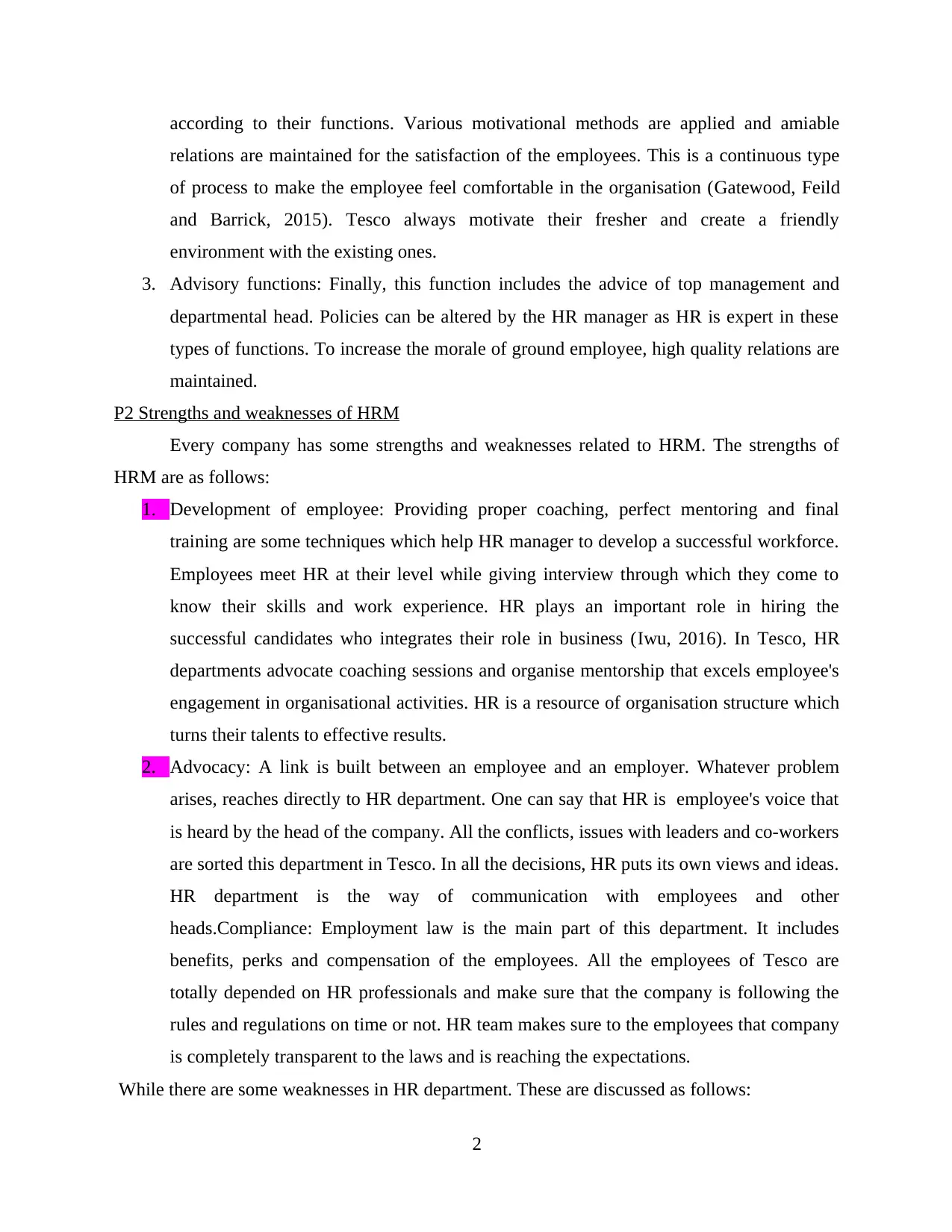
according to their functions. Various motivational methods are applied and amiable
relations are maintained for the satisfaction of the employees. This is a continuous type
of process to make the employee feel comfortable in the organisation (Gatewood, Feild
and Barrick, 2015). Tesco always motivate their fresher and create a friendly
environment with the existing ones.
3. Advisory functions: Finally, this function includes the advice of top management and
departmental head. Policies can be altered by the HR manager as HR is expert in these
types of functions. To increase the morale of ground employee, high quality relations are
maintained.
P2 Strengths and weaknesses of HRM
Every company has some strengths and weaknesses related to HRM. The strengths of
HRM are as follows:
1. Development of employee: Providing proper coaching, perfect mentoring and final
training are some techniques which help HR manager to develop a successful workforce.
Employees meet HR at their level while giving interview through which they come to
know their skills and work experience. HR plays an important role in hiring the
successful candidates who integrates their role in business (Iwu, 2016). In Tesco, HR
departments advocate coaching sessions and organise mentorship that excels employee's
engagement in organisational activities. HR is a resource of organisation structure which
turns their talents to effective results.
2. Advocacy: A link is built between an employee and an employer. Whatever problem
arises, reaches directly to HR department. One can say that HR is employee's voice that
is heard by the head of the company. All the conflicts, issues with leaders and co-workers
are sorted this department in Tesco. In all the decisions, HR puts its own views and ideas.
HR department is the way of communication with employees and other
heads.Compliance: Employment law is the main part of this department. It includes
benefits, perks and compensation of the employees. All the employees of Tesco are
totally depended on HR professionals and make sure that the company is following the
rules and regulations on time or not. HR team makes sure to the employees that company
is completely transparent to the laws and is reaching the expectations.
While there are some weaknesses in HR department. These are discussed as follows:
2
relations are maintained for the satisfaction of the employees. This is a continuous type
of process to make the employee feel comfortable in the organisation (Gatewood, Feild
and Barrick, 2015). Tesco always motivate their fresher and create a friendly
environment with the existing ones.
3. Advisory functions: Finally, this function includes the advice of top management and
departmental head. Policies can be altered by the HR manager as HR is expert in these
types of functions. To increase the morale of ground employee, high quality relations are
maintained.
P2 Strengths and weaknesses of HRM
Every company has some strengths and weaknesses related to HRM. The strengths of
HRM are as follows:
1. Development of employee: Providing proper coaching, perfect mentoring and final
training are some techniques which help HR manager to develop a successful workforce.
Employees meet HR at their level while giving interview through which they come to
know their skills and work experience. HR plays an important role in hiring the
successful candidates who integrates their role in business (Iwu, 2016). In Tesco, HR
departments advocate coaching sessions and organise mentorship that excels employee's
engagement in organisational activities. HR is a resource of organisation structure which
turns their talents to effective results.
2. Advocacy: A link is built between an employee and an employer. Whatever problem
arises, reaches directly to HR department. One can say that HR is employee's voice that
is heard by the head of the company. All the conflicts, issues with leaders and co-workers
are sorted this department in Tesco. In all the decisions, HR puts its own views and ideas.
HR department is the way of communication with employees and other
heads.Compliance: Employment law is the main part of this department. It includes
benefits, perks and compensation of the employees. All the employees of Tesco are
totally depended on HR professionals and make sure that the company is following the
rules and regulations on time or not. HR team makes sure to the employees that company
is completely transparent to the laws and is reaching the expectations.
While there are some weaknesses in HR department. These are discussed as follows:
2
Secure Best Marks with AI Grader
Need help grading? Try our AI Grader for instant feedback on your assignments.
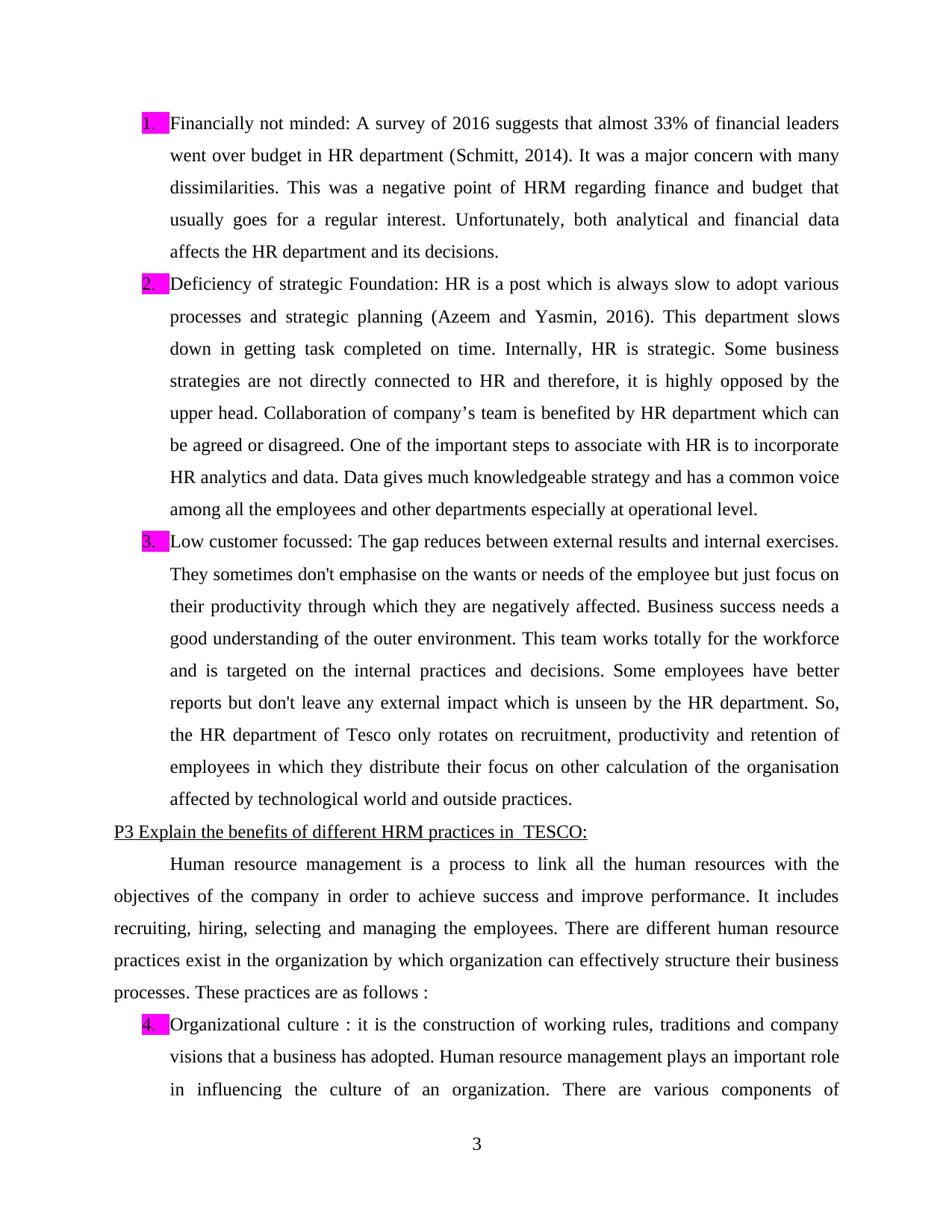
1. Financially not minded: A survey of 2016 suggests that almost 33% of financial leaders
went over budget in HR department (Schmitt, 2014). It was a major concern with many
dissimilarities. This was a negative point of HRM regarding finance and budget that
usually goes for a regular interest. Unfortunately, both analytical and financial data
affects the HR department and its decisions.
2. Deficiency of strategic Foundation: HR is a post which is always slow to adopt various
processes and strategic planning (Azeem and Yasmin, 2016). This department slows
down in getting task completed on time. Internally, HR is strategic. Some business
strategies are not directly connected to HR and therefore, it is highly opposed by the
upper head. Collaboration of company’s team is benefited by HR department which can
be agreed or disagreed. One of the important steps to associate with HR is to incorporate
HR analytics and data. Data gives much knowledgeable strategy and has a common voice
among all the employees and other departments especially at operational level.
3. Low customer focussed: The gap reduces between external results and internal exercises.
They sometimes don't emphasise on the wants or needs of the employee but just focus on
their productivity through which they are negatively affected. Business success needs a
good understanding of the outer environment. This team works totally for the workforce
and is targeted on the internal practices and decisions. Some employees have better
reports but don't leave any external impact which is unseen by the HR department. So,
the HR department of Tesco only rotates on recruitment, productivity and retention of
employees in which they distribute their focus on other calculation of the organisation
affected by technological world and outside practices.
P3 Explain the benefits of different HRM practices in TESCO:
Human resource management is a process to link all the human resources with the
objectives of the company in order to achieve success and improve performance. It includes
recruiting, hiring, selecting and managing the employees. There are different human resource
practices exist in the organization by which organization can effectively structure their business
processes. These practices are as follows :
4. Organizational culture : it is the construction of working rules, traditions and company
visions that a business has adopted. Human resource management plays an important role
in influencing the culture of an organization. There are various components of
3
went over budget in HR department (Schmitt, 2014). It was a major concern with many
dissimilarities. This was a negative point of HRM regarding finance and budget that
usually goes for a regular interest. Unfortunately, both analytical and financial data
affects the HR department and its decisions.
2. Deficiency of strategic Foundation: HR is a post which is always slow to adopt various
processes and strategic planning (Azeem and Yasmin, 2016). This department slows
down in getting task completed on time. Internally, HR is strategic. Some business
strategies are not directly connected to HR and therefore, it is highly opposed by the
upper head. Collaboration of company’s team is benefited by HR department which can
be agreed or disagreed. One of the important steps to associate with HR is to incorporate
HR analytics and data. Data gives much knowledgeable strategy and has a common voice
among all the employees and other departments especially at operational level.
3. Low customer focussed: The gap reduces between external results and internal exercises.
They sometimes don't emphasise on the wants or needs of the employee but just focus on
their productivity through which they are negatively affected. Business success needs a
good understanding of the outer environment. This team works totally for the workforce
and is targeted on the internal practices and decisions. Some employees have better
reports but don't leave any external impact which is unseen by the HR department. So,
the HR department of Tesco only rotates on recruitment, productivity and retention of
employees in which they distribute their focus on other calculation of the organisation
affected by technological world and outside practices.
P3 Explain the benefits of different HRM practices in TESCO:
Human resource management is a process to link all the human resources with the
objectives of the company in order to achieve success and improve performance. It includes
recruiting, hiring, selecting and managing the employees. There are different human resource
practices exist in the organization by which organization can effectively structure their business
processes. These practices are as follows :
4. Organizational culture : it is the construction of working rules, traditions and company
visions that a business has adopted. Human resource management plays an important role
in influencing the culture of an organization. There are various components of
3
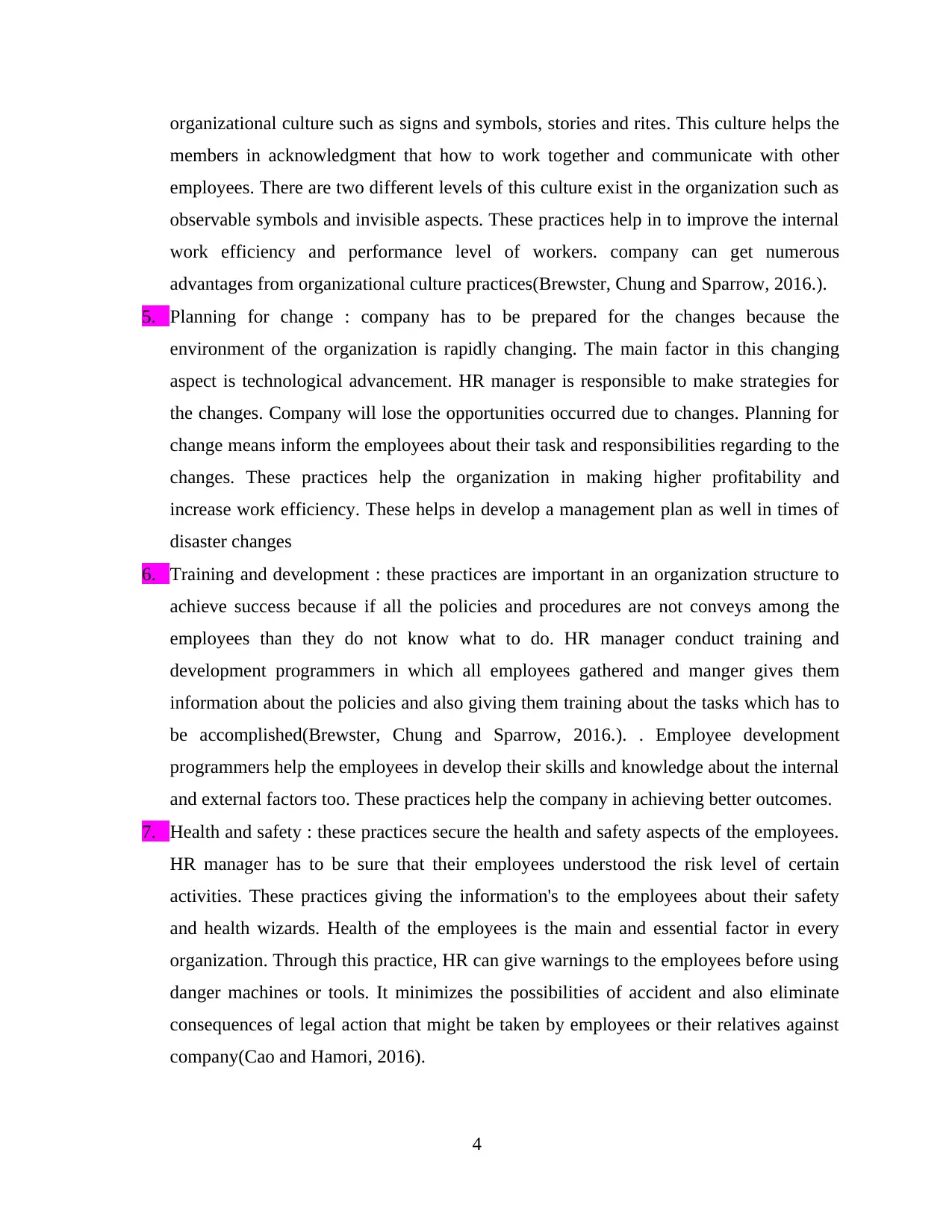
organizational culture such as signs and symbols, stories and rites. This culture helps the
members in acknowledgment that how to work together and communicate with other
employees. There are two different levels of this culture exist in the organization such as
observable symbols and invisible aspects. These practices help in to improve the internal
work efficiency and performance level of workers. company can get numerous
advantages from organizational culture practices(Brewster, Chung and Sparrow, 2016.).
5. Planning for change : company has to be prepared for the changes because the
environment of the organization is rapidly changing. The main factor in this changing
aspect is technological advancement. HR manager is responsible to make strategies for
the changes. Company will lose the opportunities occurred due to changes. Planning for
change means inform the employees about their task and responsibilities regarding to the
changes. These practices help the organization in making higher profitability and
increase work efficiency. These helps in develop a management plan as well in times of
disaster changes
6. Training and development : these practices are important in an organization structure to
achieve success because if all the policies and procedures are not conveys among the
employees than they do not know what to do. HR manager conduct training and
development programmers in which all employees gathered and manger gives them
information about the policies and also giving them training about the tasks which has to
be accomplished(Brewster, Chung and Sparrow, 2016.). . Employee development
programmers help the employees in develop their skills and knowledge about the internal
and external factors too. These practices help the company in achieving better outcomes.
7. Health and safety : these practices secure the health and safety aspects of the employees.
HR manager has to be sure that their employees understood the risk level of certain
activities. These practices giving the information's to the employees about their safety
and health wizards. Health of the employees is the main and essential factor in every
organization. Through this practice, HR can give warnings to the employees before using
danger machines or tools. It minimizes the possibilities of accident and also eliminate
consequences of legal action that might be taken by employees or their relatives against
company(Cao and Hamori, 2016).
4
members in acknowledgment that how to work together and communicate with other
employees. There are two different levels of this culture exist in the organization such as
observable symbols and invisible aspects. These practices help in to improve the internal
work efficiency and performance level of workers. company can get numerous
advantages from organizational culture practices(Brewster, Chung and Sparrow, 2016.).
5. Planning for change : company has to be prepared for the changes because the
environment of the organization is rapidly changing. The main factor in this changing
aspect is technological advancement. HR manager is responsible to make strategies for
the changes. Company will lose the opportunities occurred due to changes. Planning for
change means inform the employees about their task and responsibilities regarding to the
changes. These practices help the organization in making higher profitability and
increase work efficiency. These helps in develop a management plan as well in times of
disaster changes
6. Training and development : these practices are important in an organization structure to
achieve success because if all the policies and procedures are not conveys among the
employees than they do not know what to do. HR manager conduct training and
development programmers in which all employees gathered and manger gives them
information about the policies and also giving them training about the tasks which has to
be accomplished(Brewster, Chung and Sparrow, 2016.). . Employee development
programmers help the employees in develop their skills and knowledge about the internal
and external factors too. These practices help the company in achieving better outcomes.
7. Health and safety : these practices secure the health and safety aspects of the employees.
HR manager has to be sure that their employees understood the risk level of certain
activities. These practices giving the information's to the employees about their safety
and health wizards. Health of the employees is the main and essential factor in every
organization. Through this practice, HR can give warnings to the employees before using
danger machines or tools. It minimizes the possibilities of accident and also eliminate
consequences of legal action that might be taken by employees or their relatives against
company(Cao and Hamori, 2016).
4
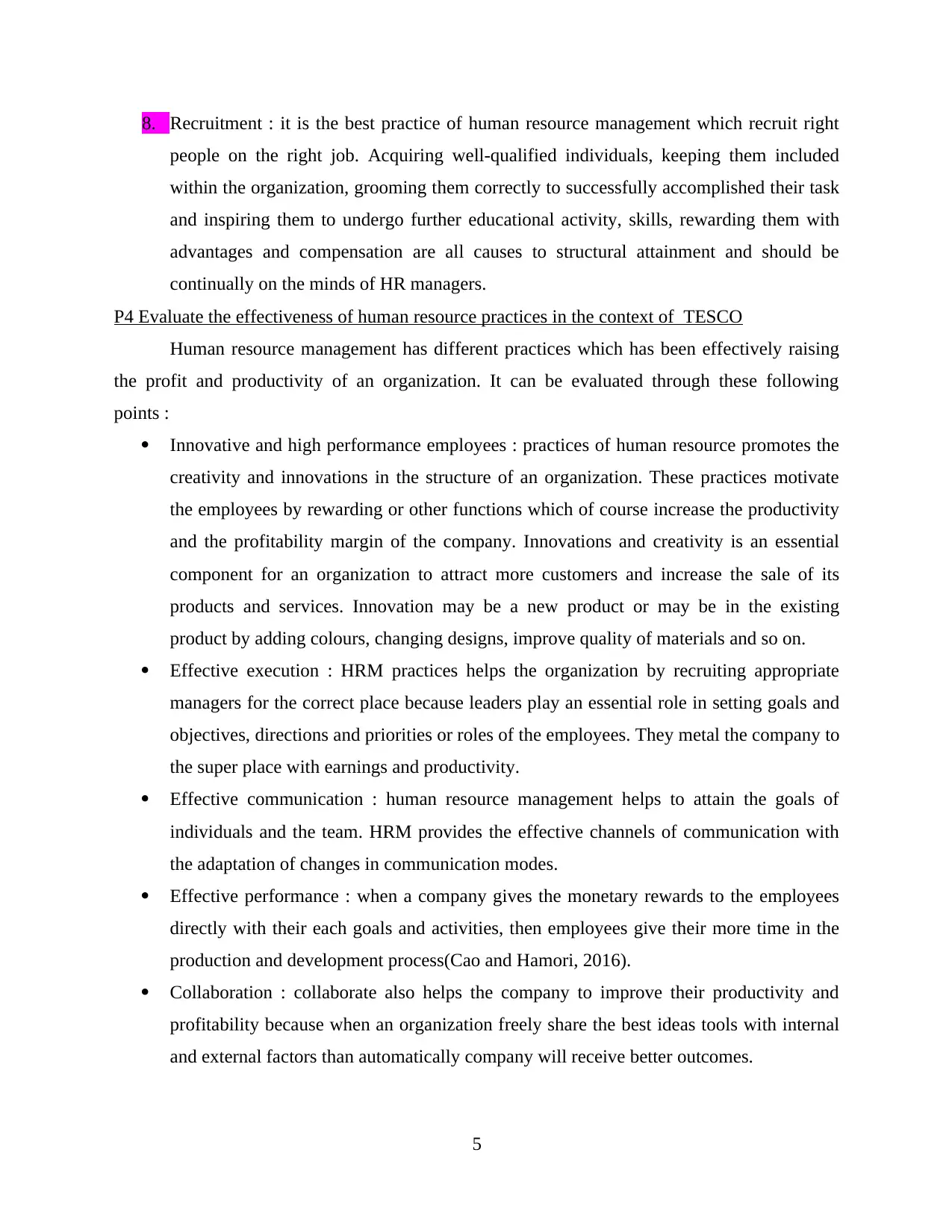
8. Recruitment : it is the best practice of human resource management which recruit right
people on the right job. Acquiring well-qualified individuals, keeping them included
within the organization, grooming them correctly to successfully accomplished their task
and inspiring them to undergo further educational activity, skills, rewarding them with
advantages and compensation are all causes to structural attainment and should be
continually on the minds of HR managers.
P4 Evaluate the effectiveness of human resource practices in the context of TESCO
Human resource management has different practices which has been effectively raising
the profit and productivity of an organization. It can be evaluated through these following
points :
Innovative and high performance employees : practices of human resource promotes the
creativity and innovations in the structure of an organization. These practices motivate
the employees by rewarding or other functions which of course increase the productivity
and the profitability margin of the company. Innovations and creativity is an essential
component for an organization to attract more customers and increase the sale of its
products and services. Innovation may be a new product or may be in the existing
product by adding colours, changing designs, improve quality of materials and so on.
Effective execution : HRM practices helps the organization by recruiting appropriate
managers for the correct place because leaders play an essential role in setting goals and
objectives, directions and priorities or roles of the employees. They metal the company to
the super place with earnings and productivity.
Effective communication : human resource management helps to attain the goals of
individuals and the team. HRM provides the effective channels of communication with
the adaptation of changes in communication modes.
Effective performance : when a company gives the monetary rewards to the employees
directly with their each goals and activities, then employees give their more time in the
production and development process(Cao and Hamori, 2016).
Collaboration : collaborate also helps the company to improve their productivity and
profitability because when an organization freely share the best ideas tools with internal
and external factors than automatically company will receive better outcomes.
5
people on the right job. Acquiring well-qualified individuals, keeping them included
within the organization, grooming them correctly to successfully accomplished their task
and inspiring them to undergo further educational activity, skills, rewarding them with
advantages and compensation are all causes to structural attainment and should be
continually on the minds of HR managers.
P4 Evaluate the effectiveness of human resource practices in the context of TESCO
Human resource management has different practices which has been effectively raising
the profit and productivity of an organization. It can be evaluated through these following
points :
Innovative and high performance employees : practices of human resource promotes the
creativity and innovations in the structure of an organization. These practices motivate
the employees by rewarding or other functions which of course increase the productivity
and the profitability margin of the company. Innovations and creativity is an essential
component for an organization to attract more customers and increase the sale of its
products and services. Innovation may be a new product or may be in the existing
product by adding colours, changing designs, improve quality of materials and so on.
Effective execution : HRM practices helps the organization by recruiting appropriate
managers for the correct place because leaders play an essential role in setting goals and
objectives, directions and priorities or roles of the employees. They metal the company to
the super place with earnings and productivity.
Effective communication : human resource management helps to attain the goals of
individuals and the team. HRM provides the effective channels of communication with
the adaptation of changes in communication modes.
Effective performance : when a company gives the monetary rewards to the employees
directly with their each goals and activities, then employees give their more time in the
production and development process(Cao and Hamori, 2016).
Collaboration : collaborate also helps the company to improve their productivity and
profitability because when an organization freely share the best ideas tools with internal
and external factors than automatically company will receive better outcomes.
5
Paraphrase This Document
Need a fresh take? Get an instant paraphrase of this document with our AI Paraphraser
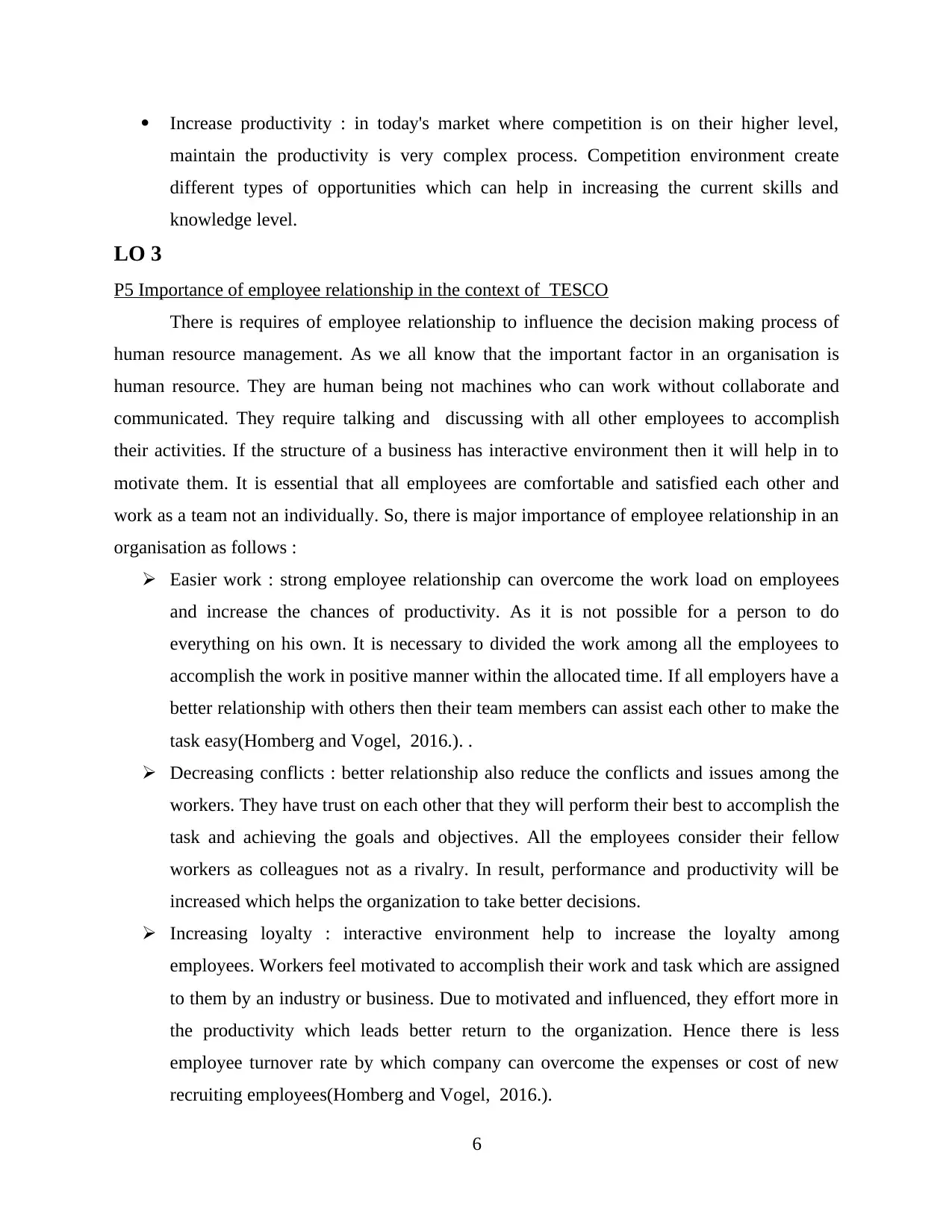
Increase productivity : in today's market where competition is on their higher level,
maintain the productivity is very complex process. Competition environment create
different types of opportunities which can help in increasing the current skills and
knowledge level.
LO 3
P5 Importance of employee relationship in the context of TESCO
There is requires of employee relationship to influence the decision making process of
human resource management. As we all know that the important factor in an organisation is
human resource. They are human being not machines who can work without collaborate and
communicated. They require talking and discussing with all other employees to accomplish
their activities. If the structure of a business has interactive environment then it will help in to
motivate them. It is essential that all employees are comfortable and satisfied each other and
work as a team not an individually. So, there is major importance of employee relationship in an
organisation as follows :
Easier work : strong employee relationship can overcome the work load on employees
and increase the chances of productivity. As it is not possible for a person to do
everything on his own. It is necessary to divided the work among all the employees to
accomplish the work in positive manner within the allocated time. If all employers have a
better relationship with others then their team members can assist each other to make the
task easy(Homberg and Vogel, 2016.). .
Decreasing conflicts : better relationship also reduce the conflicts and issues among the
workers. They have trust on each other that they will perform their best to accomplish the
task and achieving the goals and objectives. All the employees consider their fellow
workers as colleagues not as a rivalry. In result, performance and productivity will be
increased which helps the organization to take better decisions.
Increasing loyalty : interactive environment help to increase the loyalty among
employees. Workers feel motivated to accomplish their work and task which are assigned
to them by an industry or business. Due to motivated and influenced, they effort more in
the productivity which leads better return to the organization. Hence there is less
employee turnover rate by which company can overcome the expenses or cost of new
recruiting employees(Homberg and Vogel, 2016.).
6
maintain the productivity is very complex process. Competition environment create
different types of opportunities which can help in increasing the current skills and
knowledge level.
LO 3
P5 Importance of employee relationship in the context of TESCO
There is requires of employee relationship to influence the decision making process of
human resource management. As we all know that the important factor in an organisation is
human resource. They are human being not machines who can work without collaborate and
communicated. They require talking and discussing with all other employees to accomplish
their activities. If the structure of a business has interactive environment then it will help in to
motivate them. It is essential that all employees are comfortable and satisfied each other and
work as a team not an individually. So, there is major importance of employee relationship in an
organisation as follows :
Easier work : strong employee relationship can overcome the work load on employees
and increase the chances of productivity. As it is not possible for a person to do
everything on his own. It is necessary to divided the work among all the employees to
accomplish the work in positive manner within the allocated time. If all employers have a
better relationship with others then their team members can assist each other to make the
task easy(Homberg and Vogel, 2016.). .
Decreasing conflicts : better relationship also reduce the conflicts and issues among the
workers. They have trust on each other that they will perform their best to accomplish the
task and achieving the goals and objectives. All the employees consider their fellow
workers as colleagues not as a rivalry. In result, performance and productivity will be
increased which helps the organization to take better decisions.
Increasing loyalty : interactive environment help to increase the loyalty among
employees. Workers feel motivated to accomplish their work and task which are assigned
to them by an industry or business. Due to motivated and influenced, they effort more in
the productivity which leads better return to the organization. Hence there is less
employee turnover rate by which company can overcome the expenses or cost of new
recruiting employees(Homberg and Vogel, 2016.).
6
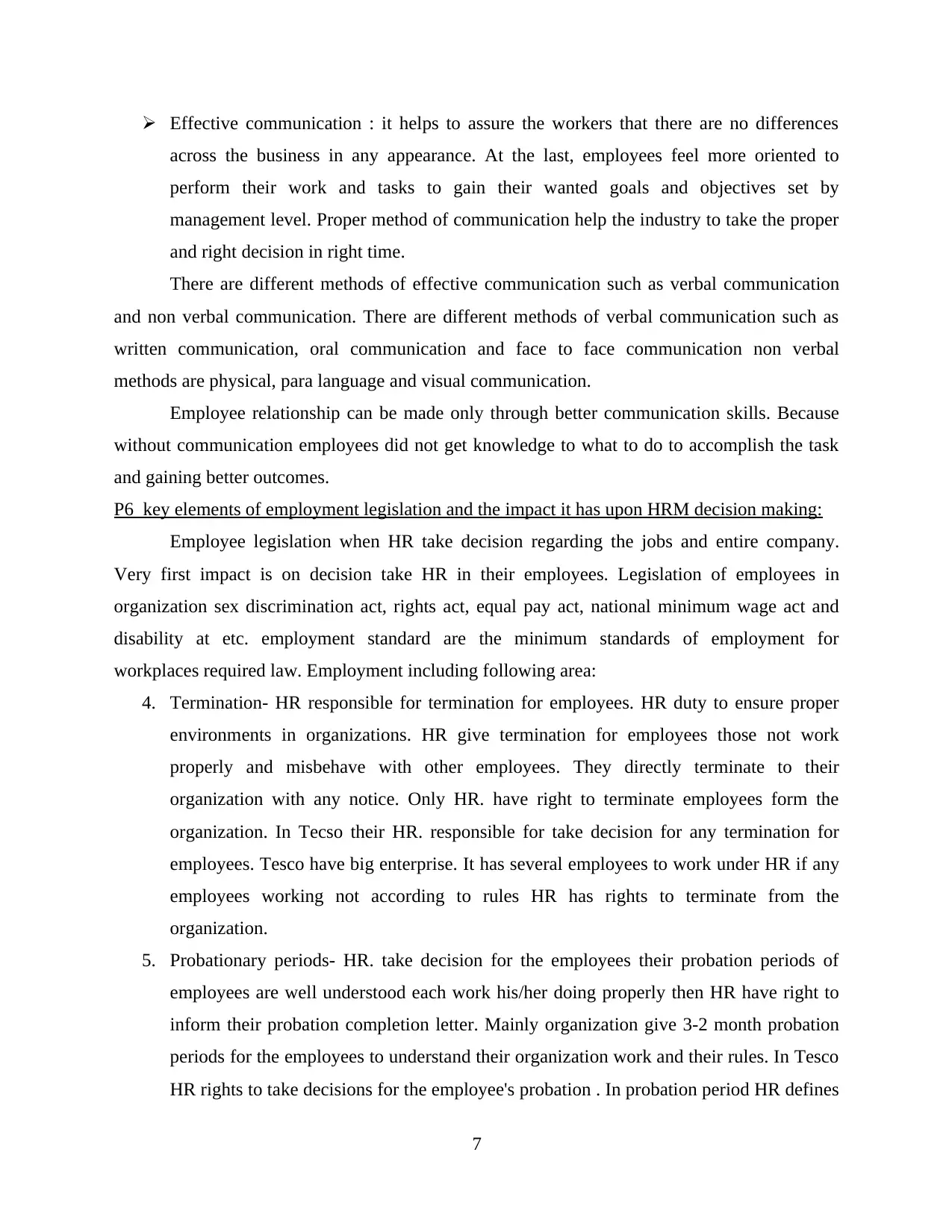
Effective communication : it helps to assure the workers that there are no differences
across the business in any appearance. At the last, employees feel more oriented to
perform their work and tasks to gain their wanted goals and objectives set by
management level. Proper method of communication help the industry to take the proper
and right decision in right time.
There are different methods of effective communication such as verbal communication
and non verbal communication. There are different methods of verbal communication such as
written communication, oral communication and face to face communication non verbal
methods are physical, para language and visual communication.
Employee relationship can be made only through better communication skills. Because
without communication employees did not get knowledge to what to do to accomplish the task
and gaining better outcomes.
P6 key elements of employment legislation and the impact it has upon HRM decision making:
Employee legislation when HR take decision regarding the jobs and entire company.
Very first impact is on decision take HR in their employees. Legislation of employees in
organization sex discrimination act, rights act, equal pay act, national minimum wage act and
disability at etc. employment standard are the minimum standards of employment for
workplaces required law. Employment including following area:
4. Termination- HR responsible for termination for employees. HR duty to ensure proper
environments in organizations. HR give termination for employees those not work
properly and misbehave with other employees. They directly terminate to their
organization with any notice. Only HR. have right to terminate employees form the
organization. In Tecso their HR. responsible for take decision for any termination for
employees. Tesco have big enterprise. It has several employees to work under HR if any
employees working not according to rules HR has rights to terminate from the
organization.
5. Probationary periods- HR. take decision for the employees their probation periods of
employees are well understood each work his/her doing properly then HR have right to
inform their probation completion letter. Mainly organization give 3-2 month probation
periods for the employees to understand their organization work and their rules. In Tesco
HR rights to take decisions for the employee's probation . In probation period HR defines
7
across the business in any appearance. At the last, employees feel more oriented to
perform their work and tasks to gain their wanted goals and objectives set by
management level. Proper method of communication help the industry to take the proper
and right decision in right time.
There are different methods of effective communication such as verbal communication
and non verbal communication. There are different methods of verbal communication such as
written communication, oral communication and face to face communication non verbal
methods are physical, para language and visual communication.
Employee relationship can be made only through better communication skills. Because
without communication employees did not get knowledge to what to do to accomplish the task
and gaining better outcomes.
P6 key elements of employment legislation and the impact it has upon HRM decision making:
Employee legislation when HR take decision regarding the jobs and entire company.
Very first impact is on decision take HR in their employees. Legislation of employees in
organization sex discrimination act, rights act, equal pay act, national minimum wage act and
disability at etc. employment standard are the minimum standards of employment for
workplaces required law. Employment including following area:
4. Termination- HR responsible for termination for employees. HR duty to ensure proper
environments in organizations. HR give termination for employees those not work
properly and misbehave with other employees. They directly terminate to their
organization with any notice. Only HR. have right to terminate employees form the
organization. In Tecso their HR. responsible for take decision for any termination for
employees. Tesco have big enterprise. It has several employees to work under HR if any
employees working not according to rules HR has rights to terminate from the
organization.
5. Probationary periods- HR. take decision for the employees their probation periods of
employees are well understood each work his/her doing properly then HR have right to
inform their probation completion letter. Mainly organization give 3-2 month probation
periods for the employees to understand their organization work and their rules. In Tesco
HR rights to take decisions for the employee's probation . In probation period HR defines
7
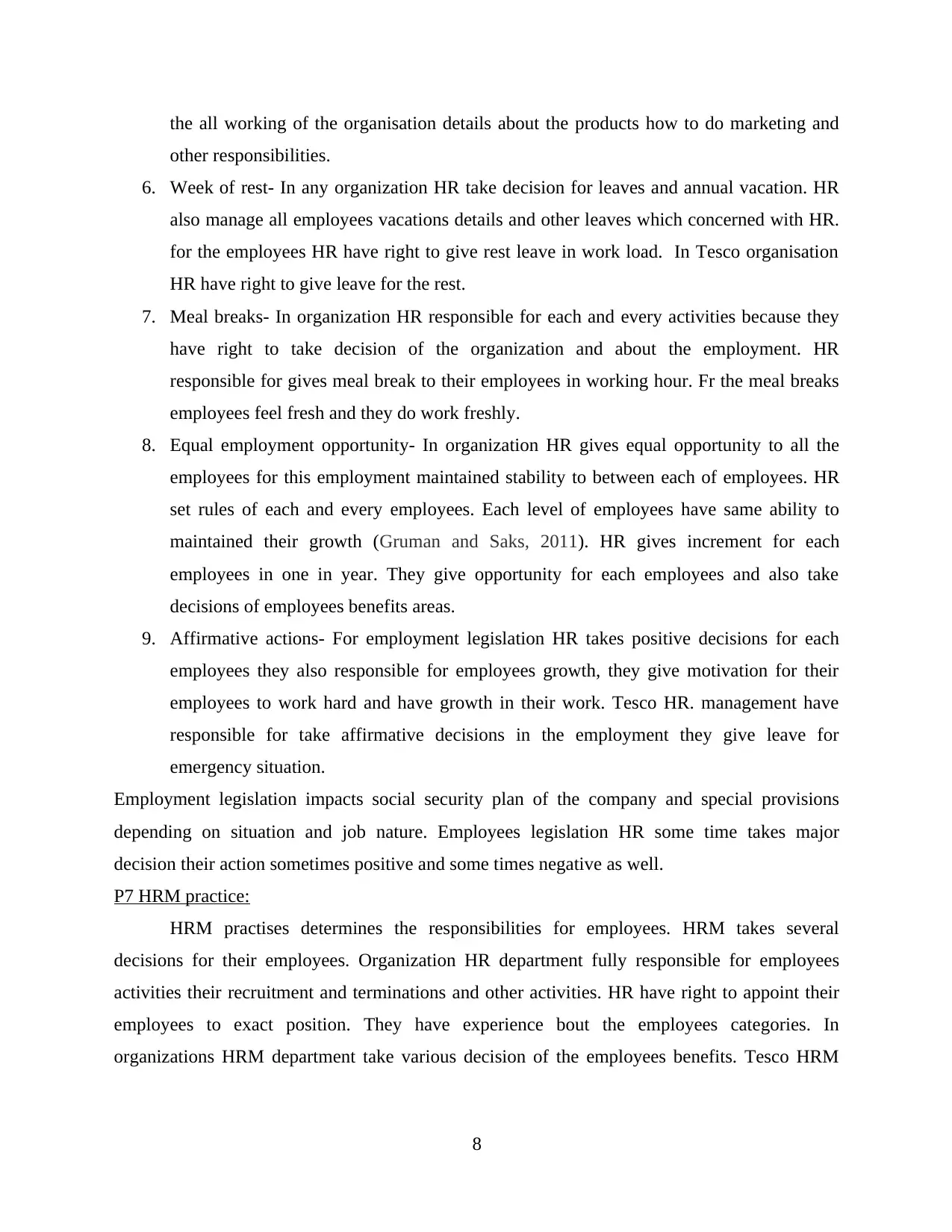
the all working of the organisation details about the products how to do marketing and
other responsibilities.
6. Week of rest- In any organization HR take decision for leaves and annual vacation. HR
also manage all employees vacations details and other leaves which concerned with HR.
for the employees HR have right to give rest leave in work load. In Tesco organisation
HR have right to give leave for the rest.
7. Meal breaks- In organization HR responsible for each and every activities because they
have right to take decision of the organization and about the employment. HR
responsible for gives meal break to their employees in working hour. Fr the meal breaks
employees feel fresh and they do work freshly.
8. Equal employment opportunity- In organization HR gives equal opportunity to all the
employees for this employment maintained stability to between each of employees. HR
set rules of each and every employees. Each level of employees have same ability to
maintained their growth (Gruman and Saks, 2011). HR gives increment for each
employees in one in year. They give opportunity for each employees and also take
decisions of employees benefits areas.
9. Affirmative actions- For employment legislation HR takes positive decisions for each
employees they also responsible for employees growth, they give motivation for their
employees to work hard and have growth in their work. Tesco HR. management have
responsible for take affirmative decisions in the employment they give leave for
emergency situation.
Employment legislation impacts social security plan of the company and special provisions
depending on situation and job nature. Employees legislation HR some time takes major
decision their action sometimes positive and some times negative as well.
P7 HRM practice:
HRM practises determines the responsibilities for employees. HRM takes several
decisions for their employees. Organization HR department fully responsible for employees
activities their recruitment and terminations and other activities. HR have right to appoint their
employees to exact position. They have experience bout the employees categories. In
organizations HRM department take various decision of the employees benefits. Tesco HRM
8
other responsibilities.
6. Week of rest- In any organization HR take decision for leaves and annual vacation. HR
also manage all employees vacations details and other leaves which concerned with HR.
for the employees HR have right to give rest leave in work load. In Tesco organisation
HR have right to give leave for the rest.
7. Meal breaks- In organization HR responsible for each and every activities because they
have right to take decision of the organization and about the employment. HR
responsible for gives meal break to their employees in working hour. Fr the meal breaks
employees feel fresh and they do work freshly.
8. Equal employment opportunity- In organization HR gives equal opportunity to all the
employees for this employment maintained stability to between each of employees. HR
set rules of each and every employees. Each level of employees have same ability to
maintained their growth (Gruman and Saks, 2011). HR gives increment for each
employees in one in year. They give opportunity for each employees and also take
decisions of employees benefits areas.
9. Affirmative actions- For employment legislation HR takes positive decisions for each
employees they also responsible for employees growth, they give motivation for their
employees to work hard and have growth in their work. Tesco HR. management have
responsible for take affirmative decisions in the employment they give leave for
emergency situation.
Employment legislation impacts social security plan of the company and special provisions
depending on situation and job nature. Employees legislation HR some time takes major
decision their action sometimes positive and some times negative as well.
P7 HRM practice:
HRM practises determines the responsibilities for employees. HRM takes several
decisions for their employees. Organization HR department fully responsible for employees
activities their recruitment and terminations and other activities. HR have right to appoint their
employees to exact position. They have experience bout the employees categories. In
organizations HRM department take various decision of the employees benefits. Tesco HRM
8
Secure Best Marks with AI Grader
Need help grading? Try our AI Grader for instant feedback on your assignments.
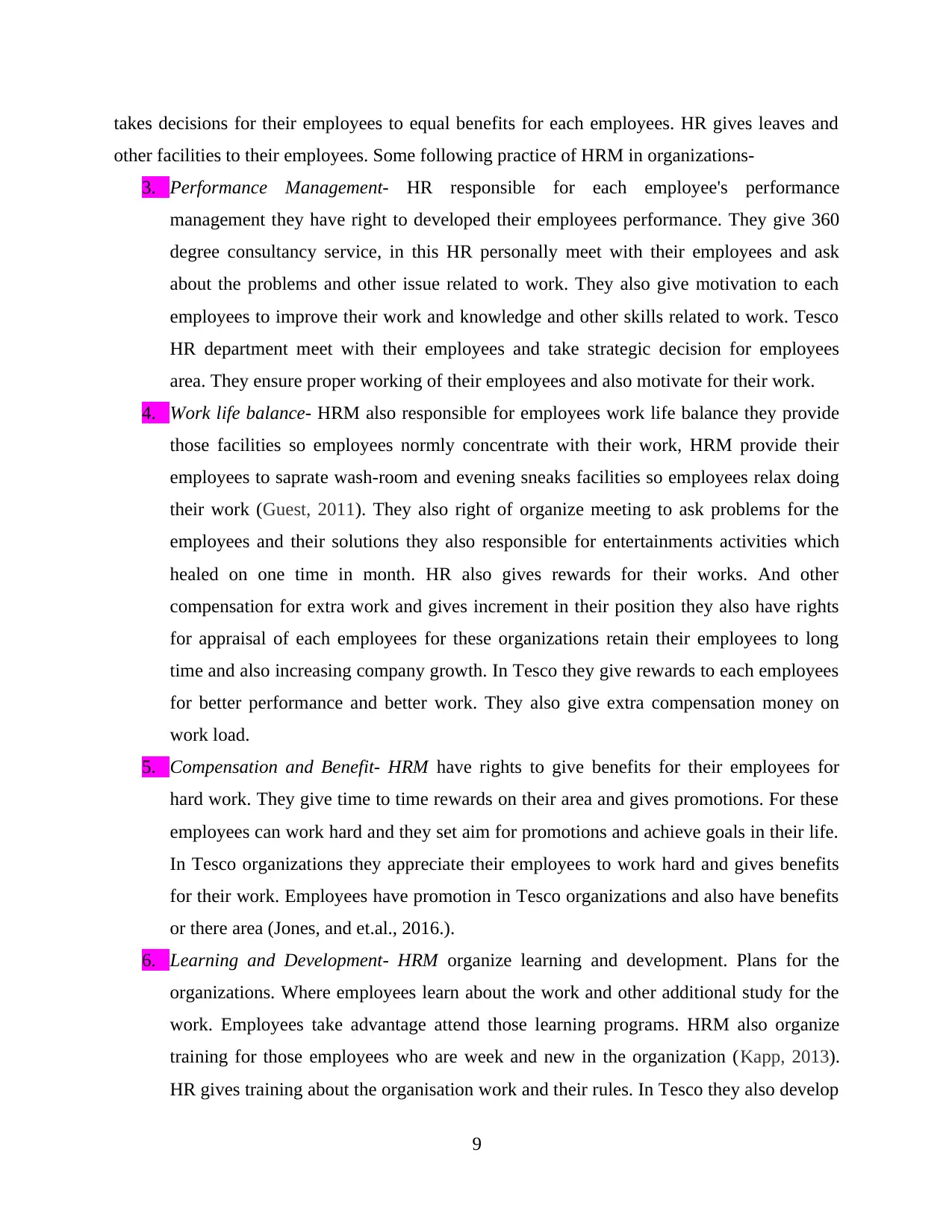
takes decisions for their employees to equal benefits for each employees. HR gives leaves and
other facilities to their employees. Some following practice of HRM in organizations-
3. Performance Management- HR responsible for each employee's performance
management they have right to developed their employees performance. They give 360
degree consultancy service, in this HR personally meet with their employees and ask
about the problems and other issue related to work. They also give motivation to each
employees to improve their work and knowledge and other skills related to work. Tesco
HR department meet with their employees and take strategic decision for employees
area. They ensure proper working of their employees and also motivate for their work.
4. Work life balance- HRM also responsible for employees work life balance they provide
those facilities so employees normly concentrate with their work, HRM provide their
employees to saprate wash-room and evening sneaks facilities so employees relax doing
their work (Guest, 2011). They also right of organize meeting to ask problems for the
employees and their solutions they also responsible for entertainments activities which
healed on one time in month. HR also gives rewards for their works. And other
compensation for extra work and gives increment in their position they also have rights
for appraisal of each employees for these organizations retain their employees to long
time and also increasing company growth. In Tesco they give rewards to each employees
for better performance and better work. They also give extra compensation money on
work load.
5. Compensation and Benefit- HRM have rights to give benefits for their employees for
hard work. They give time to time rewards on their area and gives promotions. For these
employees can work hard and they set aim for promotions and achieve goals in their life.
In Tesco organizations they appreciate their employees to work hard and gives benefits
for their work. Employees have promotion in Tesco organizations and also have benefits
or there area (Jones, and et.al., 2016.).
6. Learning and Development- HRM organize learning and development. Plans for the
organizations. Where employees learn about the work and other additional study for the
work. Employees take advantage attend those learning programs. HRM also organize
training for those employees who are week and new in the organization (Kapp, 2013).
HR gives training about the organisation work and their rules. In Tesco they also develop
9
other facilities to their employees. Some following practice of HRM in organizations-
3. Performance Management- HR responsible for each employee's performance
management they have right to developed their employees performance. They give 360
degree consultancy service, in this HR personally meet with their employees and ask
about the problems and other issue related to work. They also give motivation to each
employees to improve their work and knowledge and other skills related to work. Tesco
HR department meet with their employees and take strategic decision for employees
area. They ensure proper working of their employees and also motivate for their work.
4. Work life balance- HRM also responsible for employees work life balance they provide
those facilities so employees normly concentrate with their work, HRM provide their
employees to saprate wash-room and evening sneaks facilities so employees relax doing
their work (Guest, 2011). They also right of organize meeting to ask problems for the
employees and their solutions they also responsible for entertainments activities which
healed on one time in month. HR also gives rewards for their works. And other
compensation for extra work and gives increment in their position they also have rights
for appraisal of each employees for these organizations retain their employees to long
time and also increasing company growth. In Tesco they give rewards to each employees
for better performance and better work. They also give extra compensation money on
work load.
5. Compensation and Benefit- HRM have rights to give benefits for their employees for
hard work. They give time to time rewards on their area and gives promotions. For these
employees can work hard and they set aim for promotions and achieve goals in their life.
In Tesco organizations they appreciate their employees to work hard and gives benefits
for their work. Employees have promotion in Tesco organizations and also have benefits
or there area (Jones, and et.al., 2016.).
6. Learning and Development- HRM organize learning and development. Plans for the
organizations. Where employees learn about the work and other additional study for the
work. Employees take advantage attend those learning programs. HRM also organize
training for those employees who are week and new in the organization (Kapp, 2013).
HR gives training about the organisation work and their rules. In Tesco they also develop
9
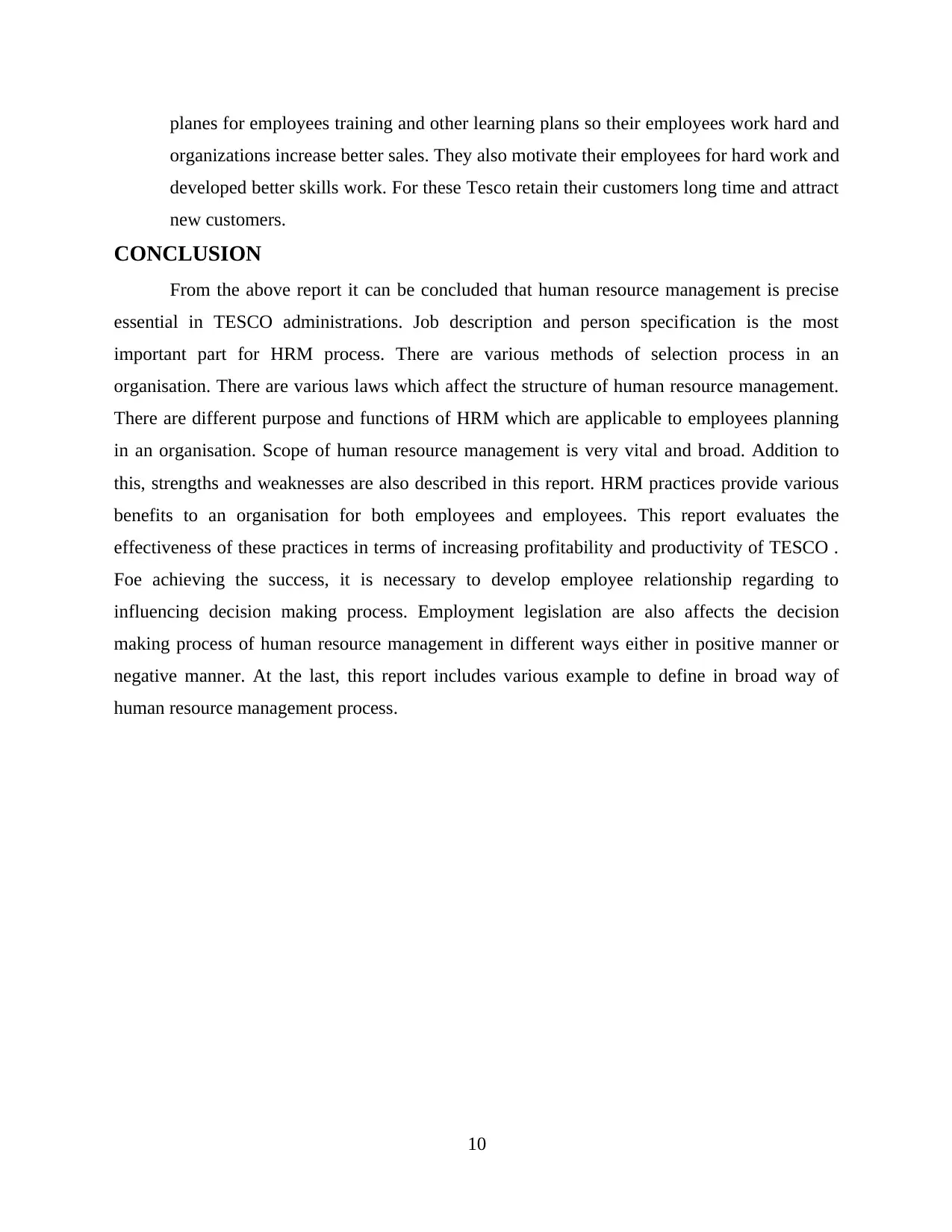
planes for employees training and other learning plans so their employees work hard and
organizations increase better sales. They also motivate their employees for hard work and
developed better skills work. For these Tesco retain their customers long time and attract
new customers.
CONCLUSION
From the above report it can be concluded that human resource management is precise
essential in TESCO administrations. Job description and person specification is the most
important part for HRM process. There are various methods of selection process in an
organisation. There are various laws which affect the structure of human resource management.
There are different purpose and functions of HRM which are applicable to employees planning
in an organisation. Scope of human resource management is very vital and broad. Addition to
this, strengths and weaknesses are also described in this report. HRM practices provide various
benefits to an organisation for both employees and employees. This report evaluates the
effectiveness of these practices in terms of increasing profitability and productivity of TESCO .
Foe achieving the success, it is necessary to develop employee relationship regarding to
influencing decision making process. Employment legislation are also affects the decision
making process of human resource management in different ways either in positive manner or
negative manner. At the last, this report includes various example to define in broad way of
human resource management process.
10
organizations increase better sales. They also motivate their employees for hard work and
developed better skills work. For these Tesco retain their customers long time and attract
new customers.
CONCLUSION
From the above report it can be concluded that human resource management is precise
essential in TESCO administrations. Job description and person specification is the most
important part for HRM process. There are various methods of selection process in an
organisation. There are various laws which affect the structure of human resource management.
There are different purpose and functions of HRM which are applicable to employees planning
in an organisation. Scope of human resource management is very vital and broad. Addition to
this, strengths and weaknesses are also described in this report. HRM practices provide various
benefits to an organisation for both employees and employees. This report evaluates the
effectiveness of these practices in terms of increasing profitability and productivity of TESCO .
Foe achieving the success, it is necessary to develop employee relationship regarding to
influencing decision making process. Employment legislation are also affects the decision
making process of human resource management in different ways either in positive manner or
negative manner. At the last, this report includes various example to define in broad way of
human resource management process.
10
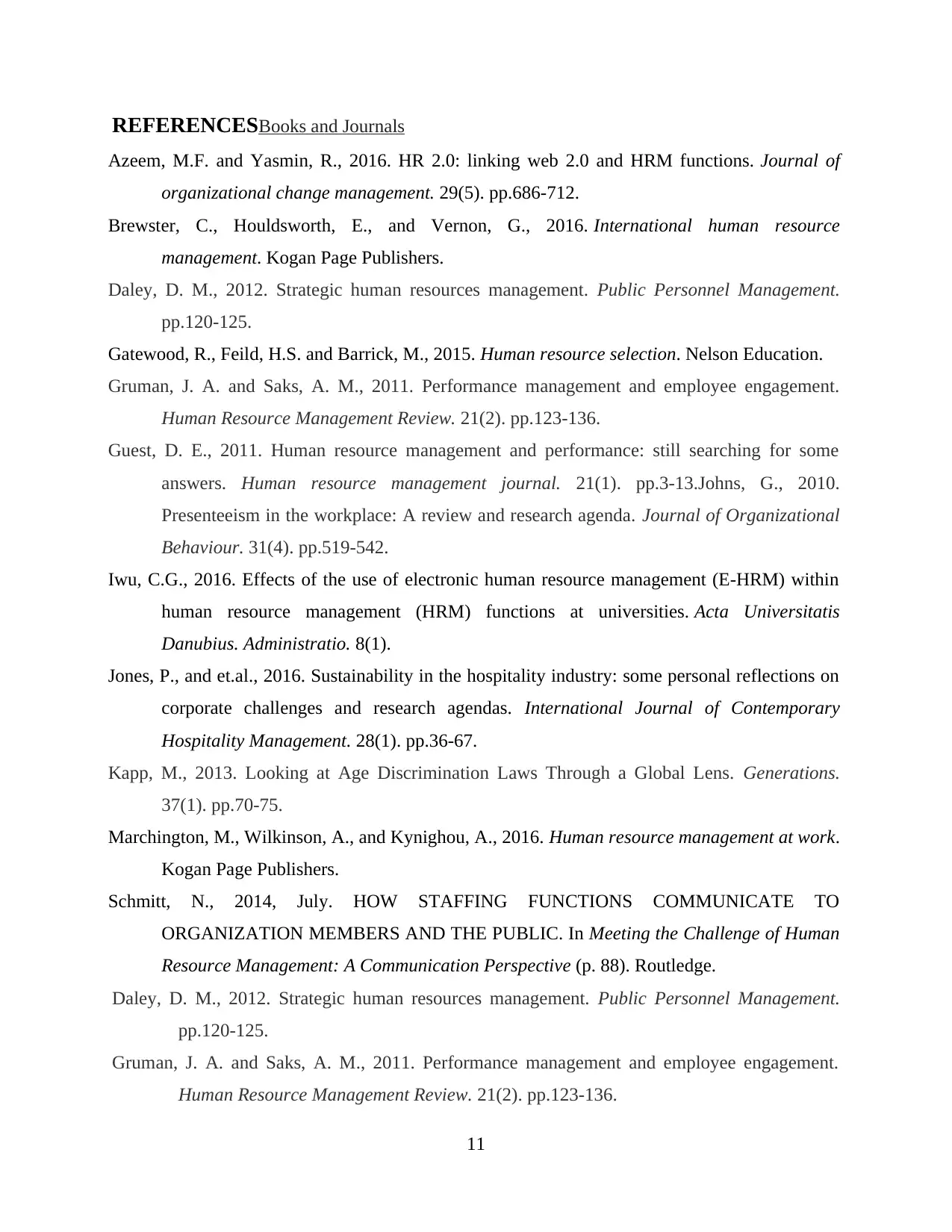
REFERENCESBooks and Journals
Azeem, M.F. and Yasmin, R., 2016. HR 2.0: linking web 2.0 and HRM functions. Journal of
organizational change management. 29(5). pp.686-712.
Brewster, C., Houldsworth, E., and Vernon, G., 2016. International human resource
management. Kogan Page Publishers.
Daley, D. M., 2012. Strategic human resources management. Public Personnel Management.
pp.120-125.
Gatewood, R., Feild, H.S. and Barrick, M., 2015. Human resource selection. Nelson Education.
Gruman, J. A. and Saks, A. M., 2011. Performance management and employee engagement.
Human Resource Management Review. 21(2). pp.123-136.
Guest, D. E., 2011. Human resource management and performance: still searching for some
answers. Human resource management journal. 21(1). pp.3-13.Johns, G., 2010.
Presenteeism in the workplace: A review and research agenda. Journal of Organizational
Behaviour. 31(4). pp.519-542.
Iwu, C.G., 2016. Effects of the use of electronic human resource management (E-HRM) within
human resource management (HRM) functions at universities. Acta Universitatis
Danubius. Administratio. 8(1).
Jones, P., and et.al., 2016. Sustainability in the hospitality industry: some personal reflections on
corporate challenges and research agendas. International Journal of Contemporary
Hospitality Management. 28(1). pp.36-67.
Kapp, M., 2013. Looking at Age Discrimination Laws Through a Global Lens. Generations.
37(1). pp.70-75.
Marchington, M., Wilkinson, A., and Kynighou, A., 2016. Human resource management at work.
Kogan Page Publishers.
Schmitt, N., 2014, July. HOW STAFFING FUNCTIONS COMMUNICATE TO
ORGANIZATION MEMBERS AND THE PUBLIC. In Meeting the Challenge of Human
Resource Management: A Communication Perspective (p. 88). Routledge.
Daley, D. M., 2012. Strategic human resources management. Public Personnel Management.
pp.120-125.
Gruman, J. A. and Saks, A. M., 2011. Performance management and employee engagement.
Human Resource Management Review. 21(2). pp.123-136.
11
Azeem, M.F. and Yasmin, R., 2016. HR 2.0: linking web 2.0 and HRM functions. Journal of
organizational change management. 29(5). pp.686-712.
Brewster, C., Houldsworth, E., and Vernon, G., 2016. International human resource
management. Kogan Page Publishers.
Daley, D. M., 2012. Strategic human resources management. Public Personnel Management.
pp.120-125.
Gatewood, R., Feild, H.S. and Barrick, M., 2015. Human resource selection. Nelson Education.
Gruman, J. A. and Saks, A. M., 2011. Performance management and employee engagement.
Human Resource Management Review. 21(2). pp.123-136.
Guest, D. E., 2011. Human resource management and performance: still searching for some
answers. Human resource management journal. 21(1). pp.3-13.Johns, G., 2010.
Presenteeism in the workplace: A review and research agenda. Journal of Organizational
Behaviour. 31(4). pp.519-542.
Iwu, C.G., 2016. Effects of the use of electronic human resource management (E-HRM) within
human resource management (HRM) functions at universities. Acta Universitatis
Danubius. Administratio. 8(1).
Jones, P., and et.al., 2016. Sustainability in the hospitality industry: some personal reflections on
corporate challenges and research agendas. International Journal of Contemporary
Hospitality Management. 28(1). pp.36-67.
Kapp, M., 2013. Looking at Age Discrimination Laws Through a Global Lens. Generations.
37(1). pp.70-75.
Marchington, M., Wilkinson, A., and Kynighou, A., 2016. Human resource management at work.
Kogan Page Publishers.
Schmitt, N., 2014, July. HOW STAFFING FUNCTIONS COMMUNICATE TO
ORGANIZATION MEMBERS AND THE PUBLIC. In Meeting the Challenge of Human
Resource Management: A Communication Perspective (p. 88). Routledge.
Daley, D. M., 2012. Strategic human resources management. Public Personnel Management.
pp.120-125.
Gruman, J. A. and Saks, A. M., 2011. Performance management and employee engagement.
Human Resource Management Review. 21(2). pp.123-136.
11
Paraphrase This Document
Need a fresh take? Get an instant paraphrase of this document with our AI Paraphraser
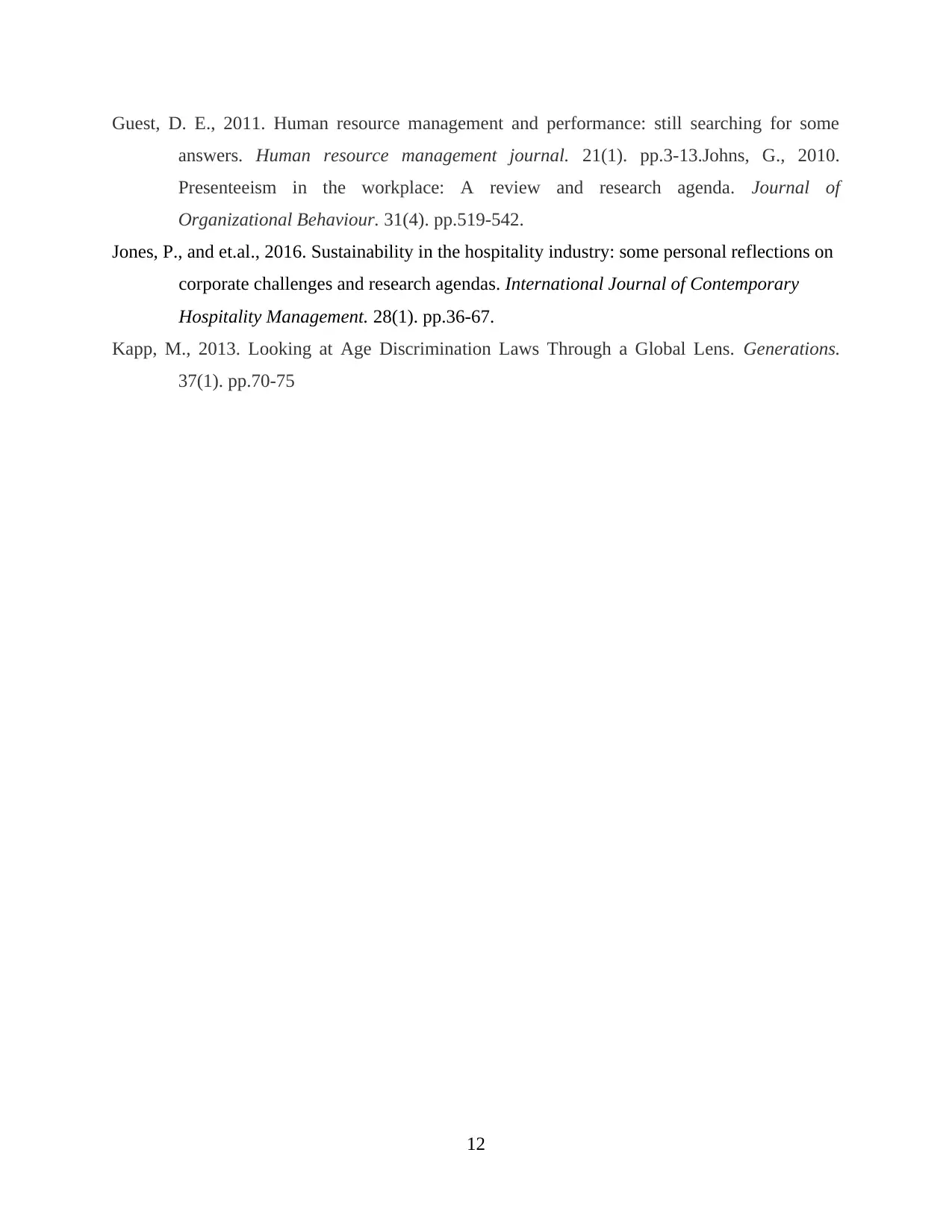
Guest, D. E., 2011. Human resource management and performance: still searching for some
answers. Human resource management journal. 21(1). pp.3-13.Johns, G., 2010.
Presenteeism in the workplace: A review and research agenda. Journal of
Organizational Behaviour. 31(4). pp.519-542.
Jones, P., and et.al., 2016. Sustainability in the hospitality industry: some personal reflections on
corporate challenges and research agendas. International Journal of Contemporary
Hospitality Management. 28(1). pp.36-67.
Kapp, M., 2013. Looking at Age Discrimination Laws Through a Global Lens. Generations.
37(1). pp.70-75
12
answers. Human resource management journal. 21(1). pp.3-13.Johns, G., 2010.
Presenteeism in the workplace: A review and research agenda. Journal of
Organizational Behaviour. 31(4). pp.519-542.
Jones, P., and et.al., 2016. Sustainability in the hospitality industry: some personal reflections on
corporate challenges and research agendas. International Journal of Contemporary
Hospitality Management. 28(1). pp.36-67.
Kapp, M., 2013. Looking at Age Discrimination Laws Through a Global Lens. Generations.
37(1). pp.70-75
12
1 out of 14
Related Documents
Your All-in-One AI-Powered Toolkit for Academic Success.
+13062052269
info@desklib.com
Available 24*7 on WhatsApp / Email
![[object Object]](/_next/static/media/star-bottom.7253800d.svg)
Unlock your academic potential
© 2024 | Zucol Services PVT LTD | All rights reserved.





